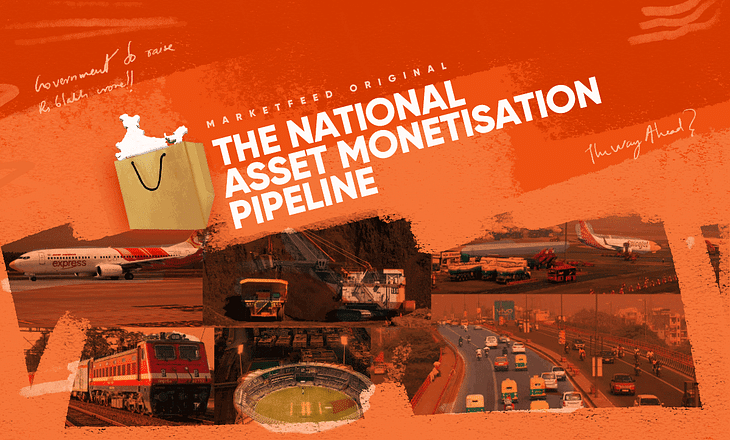Government To Raise Rs 6 Lakh Crore Through Asset Monetisation: Know More

The Indian Government has announced plans to ‘monetise’ its assets and earn up to Rs 6 lakh crores by the end of 2025 through the National Monetisation Pipeline. Now the question is, what is monetisation? When you monetise something, you either convert it into cash/currency or generate revenue from it. The Indian Government has made plans to generate revenue by monetising assets like Railway Infrastructure, Roads, Public Infrastructure, Coal Mines, Stadiums, Airports, to name a few. Let us do some deeper digging into what exactly the National Monetisation Pipeline is.
What is the National Monetisation Pipeline (NMP)?
Finance Minister Nirmala Sitharaman has announced that the government intends to monetise its assets and generate up to Rs 6 lakh crore between 2022 and 2025. Firstly, private players shall bid for projects and pay the government an upfront amount. Later, the government shall withhold the ownership rights of a project and instead give out the revenue rights to private players. The revenue rights shall be valid only till 2025. A Core Group of Secretaries on Asset Monetization (CGAM) shall be set up under the chairmanship of the Cabinet Secretary.
The NMP will run a co-terminus with the National Infrastructure Pipeline of Rs 100 lakh crore announced in December 2019. The government shall make structured partnerships under defined contractual frameworks with strict performance benchmarks. Companies bidding for these assets will have to keep up with these performance benchmarks.
The government plans to monetise only ‘de-risked or ‘brownfield’ projects. A brownfield project is an already developed project that might be dormant or have some efficiencies that could be corrected. A greenfield project is the construction of a new project on a vacant piece of land. For example - The redevelopment of an old building is a brownfield project, construction of a new building on an empty piece of land is a greenfield project.
Currently, only assets of central government line ministries and Central Public Sector Enterprises (CPSEs) in infrastructure sectors have been included. This includes more than 12 line ministries and more than 20 asset classes. The sectors included are roads, ports, airports, railways, warehousing, gas & product pipeline, power generation and transmission, mining, telecom, stadium, hospitality and housing. The top 5 sectors (by estimated value) capture ~83% of the aggregate pipeline value. These top 5 sectors include Roads (27%) followed by Railways (25%), Power (15%), oil & gas pipelines (8%) and Telecom (6%). These sectors are expected to catch the most interest from private players.
Which Stocks Are Likely To Benefit?
- Roads and Highways: Roads and highways constitute a majority of the monetisation pipeline. Companies like IRB, L&T, GMR Infra, Dilip Buildcon can be on the list
- Railways: Railways in India are wholly owned by the government. Stocks such aslike IRCTC, IRFC, Ircon, Titagarh Wagon, RITES, and RailTel could likely benefit from the move.
- Power Sector: Companies like Power Grid, Adani Transmission, KEC Intl, and GE Power, GE T&D could benefit from it.
- Adani Group: The Adani Group has its hand in the game. It is the largest private airport operator in the country. Its subsidiary Adani Airport Holdings Limited holds the highest number of airports in India (eight airports across India). Apart from these Adani Gas, Adani Green, Adani Power, Adani Enterprises could prosper from the deal.
The Way Ahead
The NMP is a part of the Modi government’s divestment and privatisation policy. It is no secret that government-owned companies function less efficiently than private companies. The NMP will enable increased efficiency and optimum utilisation of government assets. The revenue generated by leasing government assets will help fund more government projects. This move shall receive lesser resistance than usual. Unlike privatisation/divestment, the government is retaining the ownership of government assets.
Coming to the shortcomings of the NMP. The government still holds troubled assets like Air India and BPCL. It has tried yet failed to privatise them in the past. There might be a lack of identifiable revenue streams in particular assets. As for railways, the government received poor interest in its recent bidding for a Public-Private partnership for trains. The government has taken a halt to the privatisation/divestment process of the railways.
Tariffs in the power sector are regulated, and there is poor capacity utilisation in the gas and petroleum sector. These factors could hinder the process of asset monetisation plan of the government. The rest depends on how the government incentivises the whole process for private players and executes the entire scheme.
You can read the entire plan for the National Monetization Pipeline in detail at: https://www.niti.gov.in/national-monetisation-pipeline

